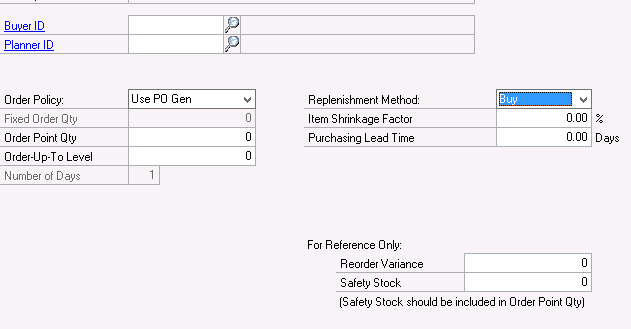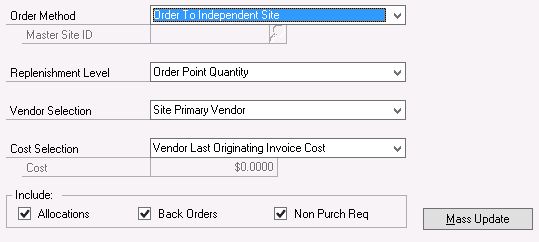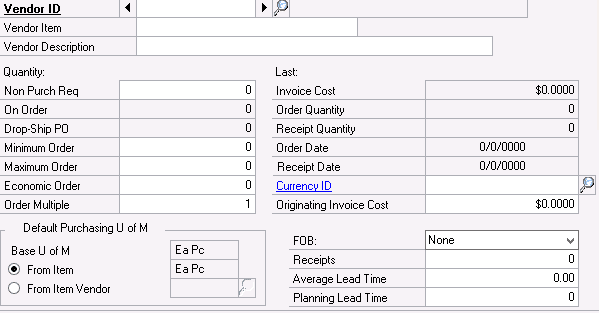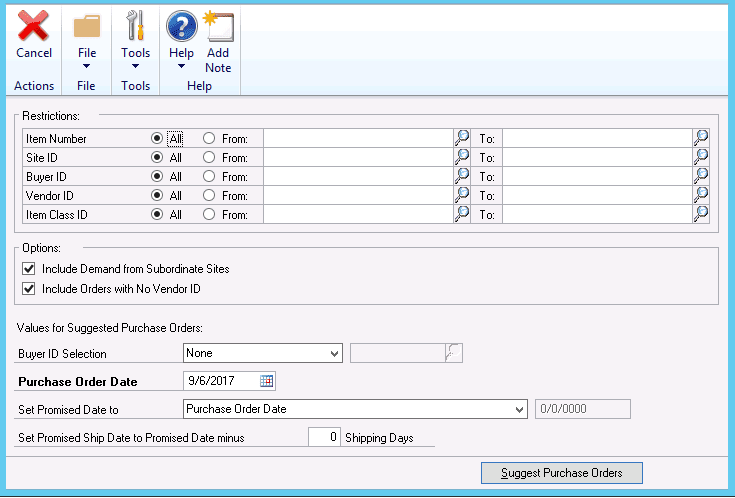We know how difficult it can be to accurately track and maintain your inventory and their reorder levels. With Microsoft Dynamics GP, the process becomes much easier.
Dynamics GP has a Purchase Order Generator feature that can analyze your inventory based on your defined requirements. This feature also allows for the automatic creation of reorder points and purchase orders to fulfill the inventory parameters you provide.
Setting Up an Item for Purchase Order Generation
To use the Microsoft Dynamics GP Purchase Order Generator, you must set up each item so that it can be used with this feature. Keep in mind, there are four main touchpoints when it comes to configuring the item for purchase order generation: Item Resource Planning, PO Gen Item, Item Vendor Maintenance, and Item Quantities and default vendor. Each of the touch points are accessed via the Item Card (Cards – Inventory – Item).
- Item Resource Planning allows the user to enable the PO Gen feature for each item.
A. To access this feature from the Item Card, Select GoTo – Item Resource Planning

B. Select the site for PO Generation
C. Change the Order Policy to User PO Gen as detailed below:

D. Other optional fields that affect the PO Generation are Order Point Qty, Order-Up-To Level, and Purchasing Lead time.
- PO Gen Item allows the user to set specific parameters for items or for item-site combinations. The parameters available are order method, replenishment method, vendor selection, and cost selection for item or item-site combination. It further allows the user to select which Order types to include for reordering requirements – Allocations, Back Orders, and Non-Purchasing Requirements. The parameters provided will determine how the item will be used in PO Generation.
- To access this feature from the Item Resource Planning screen, Select the PO Gen Item button and select the appropriate parameters.

- Order Method
- Order to Independent Site (Default) – Uses quantity requirements only from the site.
- Order to Master Site – User quantity requirements for all sites with this Master site.
- Replenishment Level
- Order Point Quantity (Default) – Order Point Quantity from Item Resource Planning screen – Available Quantity.
- Order up to Level – Order Up to Level from Item Resource Planning screen – Available Quantity.
- Vendor EOQ – Order Method must be Order to Independent Site. Order Point Quantity for site from Item Resource Planning screen – Available Quantity.
- Vendor Selection
- Site Primary Vendor (Default) – Uses the item-site Primary Vendor that is setup in the Item Quantities Maintenance screen.
- Vendor with Lowest Cost – Uses the Vendor assigned to the item with the lowest invoice cost per the Item Vendor Maintenance screen.
- Vendor with Shortest Lead Time – Uses Vendor assigned to the item with the shortest Lead Time in the Item Vendor Maintenance screen.
- Cost Selection [list-inline]
- Vendor Last Originating Invoice Cost (Default) – Uses the cost from most recent invoice from the vendor – item combination.
- Item Current Cost – Uses the Current Cost from the Item Maintenance screen.
- Item Standard Cost – Uses the Standard Cost from the Item Maintenance screen.
- Specific Cost – Uses the cost you specify.
- Item Vendor Maintenance is used to define purchasing quantity requirements for the vendor such as Minimum, Maximum, Economic, and Multiple quantities to order.
- To access this feature from the Item Card, Select GoTo – Vendors
- Select the Vendor ID

- Item Quantities to set the default Vendor used during PO Generation.
- To access this feature from the Item Card, Select GoTo – Quantity/Sites
- Select the site
- Select the Primary Vendor ID used for PO Generation for the site

To automate the PO Generation process in Dynamics GP:
- Select Transactions – Purchasing – PO Generator from the menu

- Select Restrictions or a combination of restrictions for Purchase Order Generation such as Item Number, Site ID, Buyer ID, Vendor ID, or Item Class ID. Utilize the From-To options to select your restriction.
- Include Demand from Subordinate Sites – suggestions for items to be purchased are collected from multiple sites for this item.
- Include Order with No Vendor ID – suggestions for items to be purchased will be included for items without a default Vendor ID. The Vendor can be updated on the Suggest Purchase Order screen.
- Select Buyer ID Selection for Purchase Order suggestions to use on each PO created
1: None – No Buyer ID will be on PO
2: Specified Buyer ID – Fixed ID entered
3: Item Site Buyer ID – Uses the Buyer ID from the Item Site combination on the Item Resource Planning screen
- Purchase Order Date – Will be used for the date of each PO. This value defaults to the current date.
- Set Promise Date to – Sets the promise date for the PO items for each PO created.
1: Purchase Order Date – Sets the Promise Date to the same as the PO Date
2: Purchase Order Date + Planning Lead Time – Sets the Promise Date to the PO Date plus the planning lead time
3: Specified Date – Fixed Promise Date entered by the user
- Set Promised Ship Date to Promise Date minus – Sets the ship date with an additional shipping lead time entered by the user.
- Click the Suggest Purchase Order button
- Evaluate the list of Suggested POs for Vendors, quantities, and cost on the Suggested Purchase Order screen
- Mark or Un-Mark POs as desired by using the checkbox next to each PO. Marking a PO tells the system to generate this PO and Un-Marking a PO tells the system not to create this PO.
- Evaluate Error Messages. A red X indicates that an error will prevent the suggested purchase order line item from being generated into a purchase order in Purchase Order Processing. A yellow exclamation point indicates the line contains a warning message, but can still be processed.
- Utilize the Drill Downs to evaluate the items for:
- Item Number to view Item Card
- Vendor ID to view the Vendor Card
- Vendor Item Number to view the Item Vendor Card
- Site ID to view the Item Resource Planning options
- Ship To Address ID to view the Shipping Address for the PO
- Buyer ID to view the Buyer ID for the PO
- Click the Print button to Print a list of the suggested Purchase Orders
- Click the Process Button to create the Purchase Orders in Dynamics GP
We hope you have a better understanding of how to set up the Purchase Order Generator feature in Dynamics GP. If you have any questions, or if you’d like more information, be sure to contact us. We’re happy to help.




































